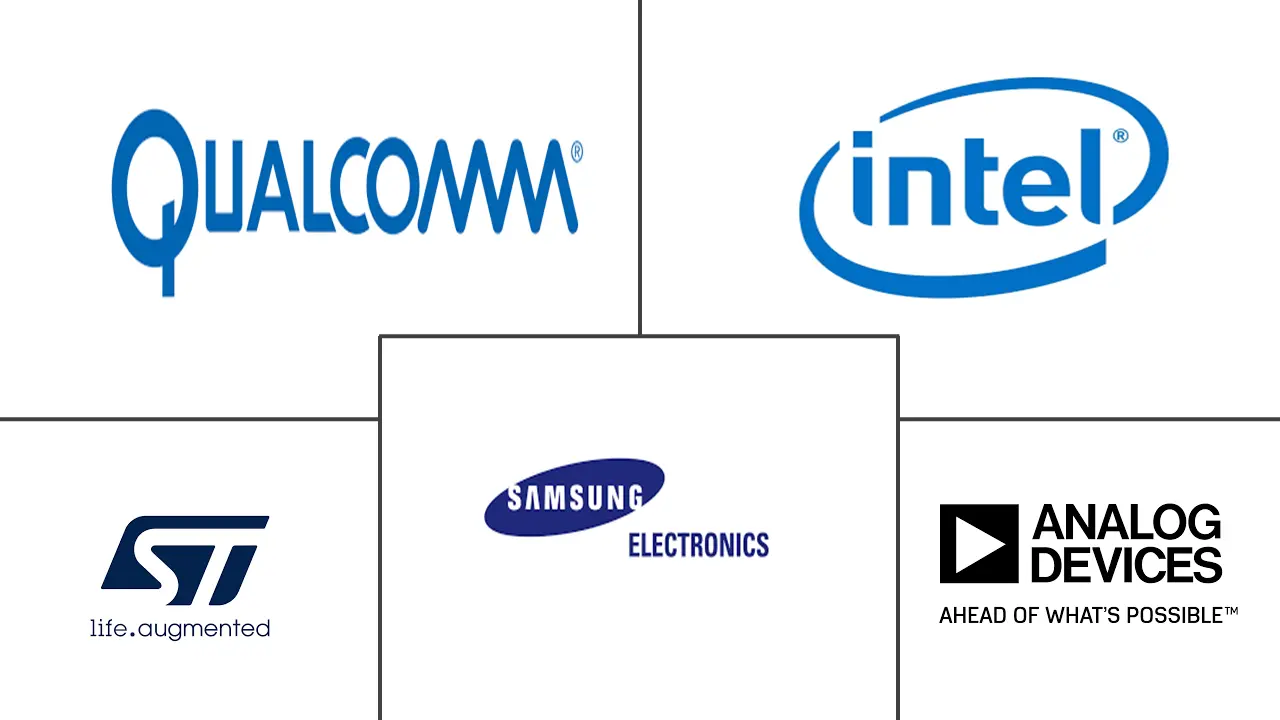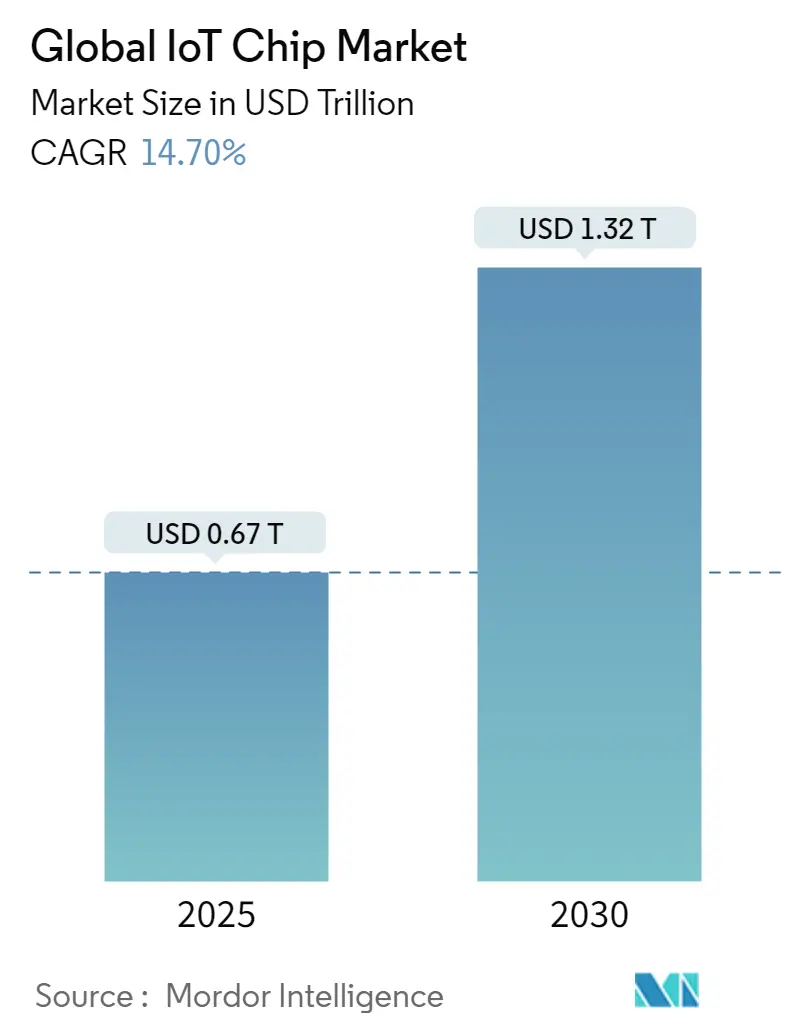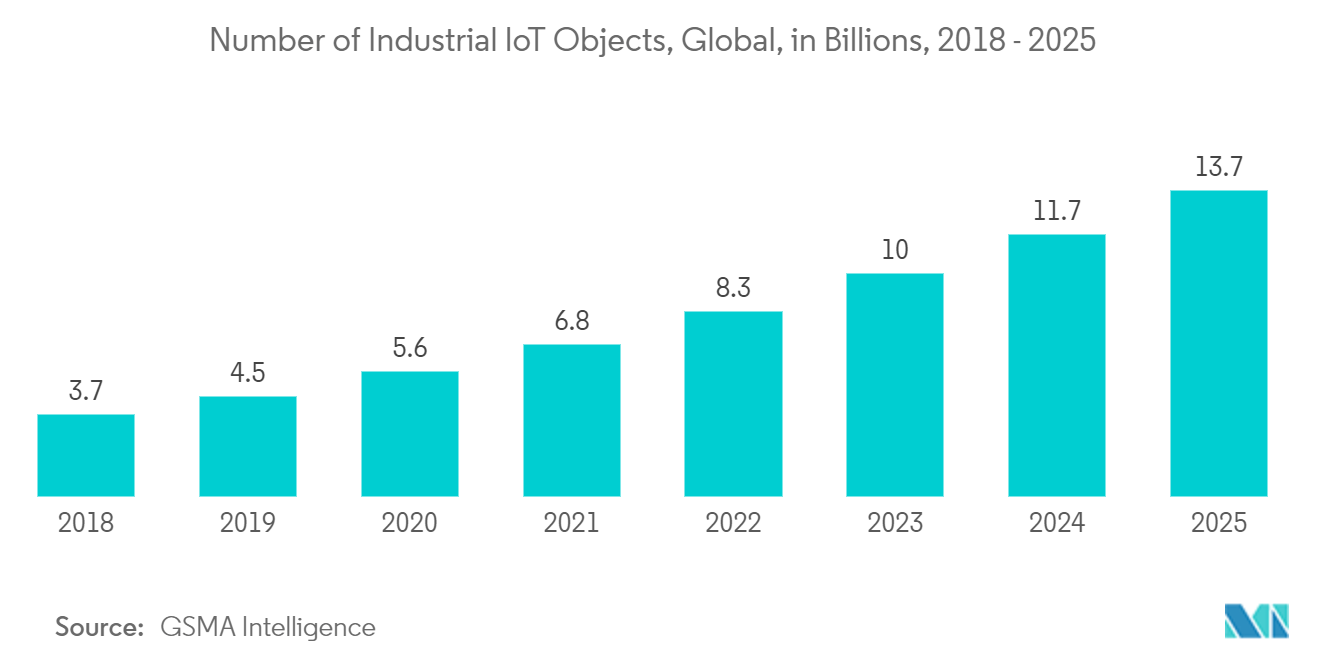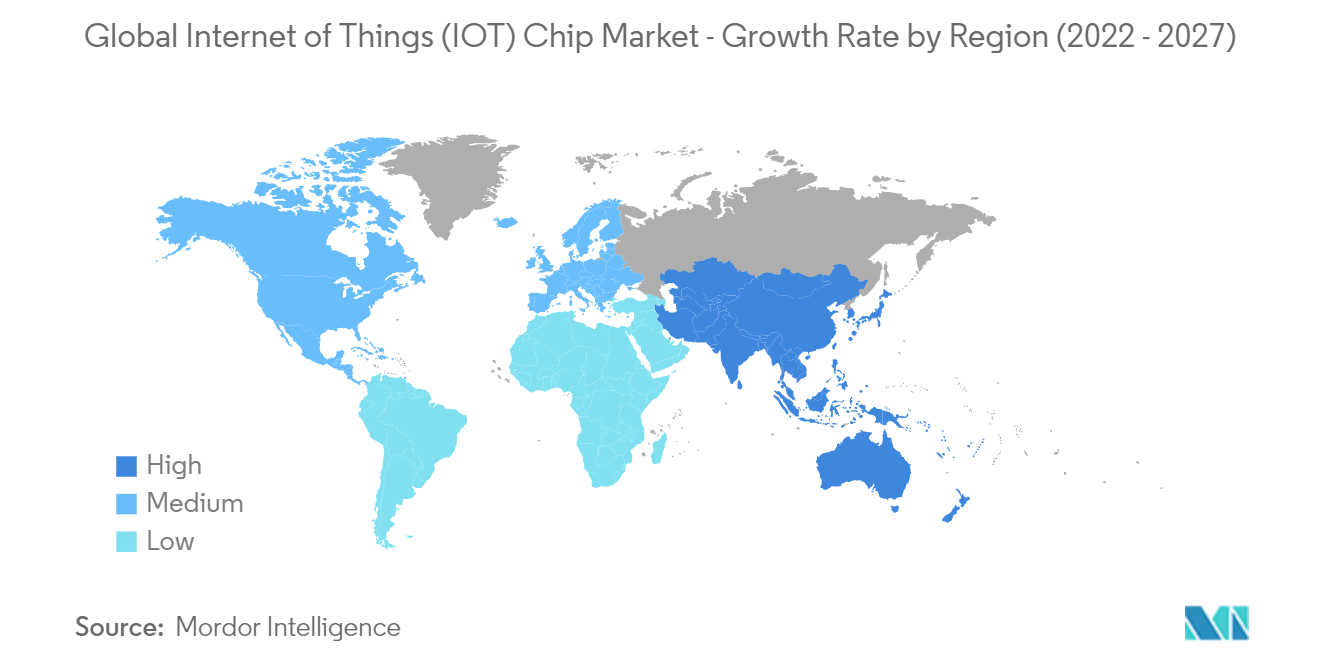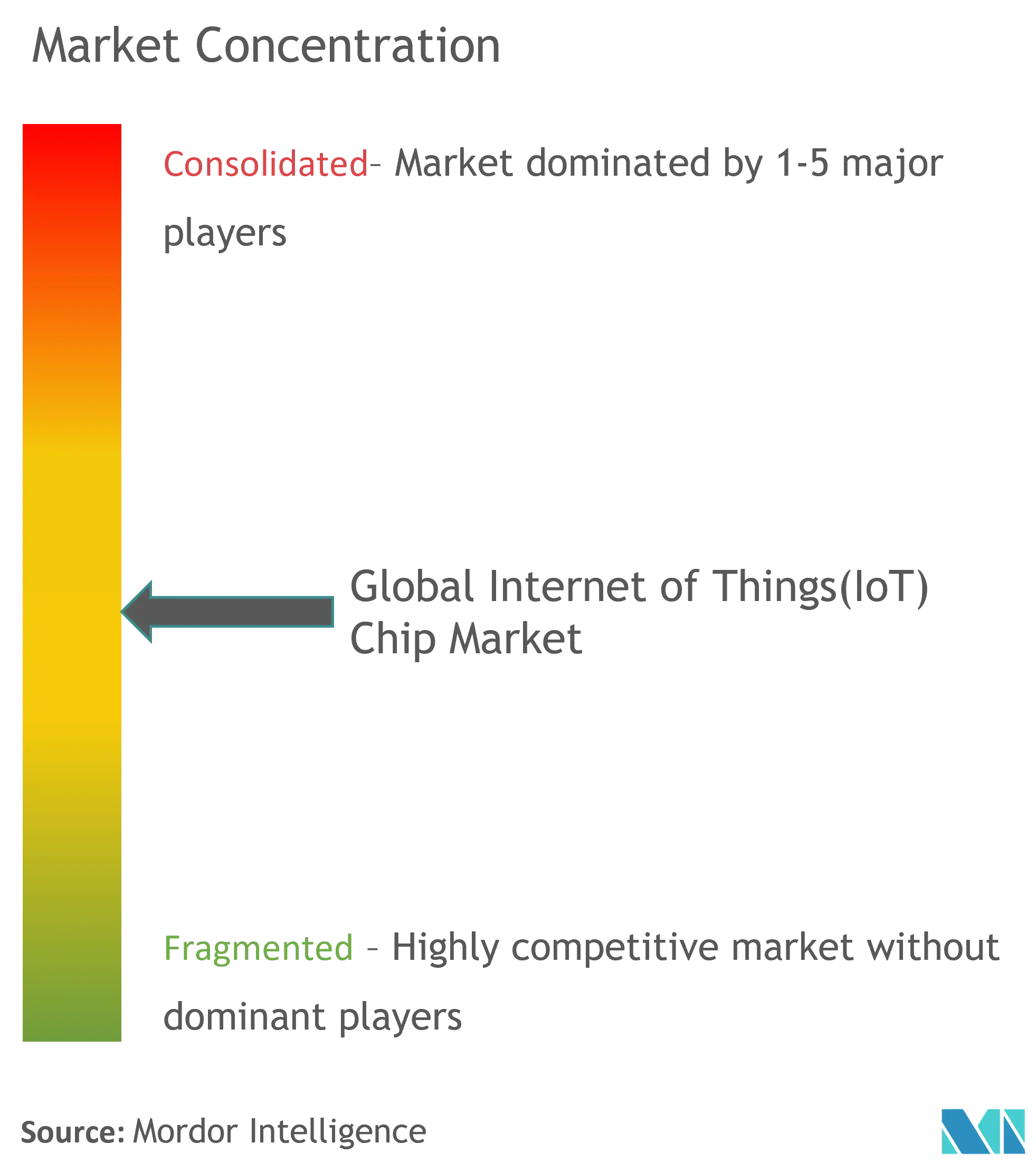IoT Chip Market Analysis
The Global IoT Chip Market size is estimated at USD 0.67 trillion in 2025, and is expected to reach USD 1.32 trillion by 2030, at a CAGR of 14.7% during the forecast period (2025-2030).
Due to demand-side and supply-side factors, the growth in the number of IoT connections slowed down in specific sectors during the pandemic. Some IoT contracts were canceled or postponed due to firms going out of business or scaling back their spending. The rising demand for automation and the growing application of IoT devices across various end-user verticals, such as healthcare, consumer electronics, industrial, automotive, BFSI, and retail, are further driving the adoption of IoT devices.
- The growth is primarily attributed to the integration of connectivity competence in a wide range of devices and applications, coupled with the development of different networking protocols that have appreciably driven the growth of the IoT chip market across multiple end-user industries.
- In March 2022, two Indian researchers working at the Massachusetts Institute of Technology (MIT) built a low-power security chip designed to prevent side-channel attacks (SCA) against Internet of Things (IoT) devices. SCA uses vulnerabilities to allow information gleaned from the indirect effects of the behavior of system hardware rather than directly attacking programs and software.
- With the rapid increase in the number of IoT devices, the chip requirement for building these IoT devices is also expected to rise over the forecast period. Along with this, reducing energy consumption combined with the miniaturization of chips will be the priority of manufacturers.
- The increased deployment of 5G provides quick and efficient connectivity for Internet-of-Things (IoT) devices. Investments in the deployment of 5G technology are expected to drive market growth during the forecast period and beyond. The integration of 5G technology is seen as the next generation of mobile internet connectivity and is expected to offer faster and more reliable connections than current technologies. Thus, the booming IoT space and the supporting chip makers are expected to increase demand for IoT chips during the forecast period.
- Rising security concerns, such as software vulnerabilities and cyberattacks, may discourage many customers from using IoT devices. Such security concerns in the Internet of Things are particularly essential to organizations in healthcare, finance, manufacturing, logistics, retail, and other industries that have already started adopting IoT systems.
- With the COVID-19 outbreak worldwide, the market was significantly affected as severe supply chain shortages occurred across the globe. Moreover, the restriction imposed by governments across the globe on the movement of people also impacted production. However, as the world recovers from the pandemic, the need for more automated and advanced processes has become a key aspect of success. As such, the market for more IoT-enabled devices is anticipated to rise in the future, thereby creating strong demand for IoT chips across the globe.
IoT Chip Market Trends
Industrial Segment is Expected to Witness Significant Growth
- Industry 4.0 and the IoT have become mainstream for new technological approaches in development, production, and logistics chains. The growing adoption of industrial 4.0 has kept IoT demand in manufacturing at maximum through increasing machine-to-machine connections and embedded sensors and the increasing need for factory efficiency on the floor and on the field.
- In July 2022, according to Economic Times's survey, cellular IoT module chipset shipments grew in India, and Qualcomm led the market with a 42% share. The company has been broadening its IoT chipset portfolio, targeting premium 4G and 5G solutions for verticals such as retail, industrial, smart cities, and more.
- Most manufacturers implement IoT devices to leverage predictive maintenance and sophisticated data analytics. This improves productivity and availability and adds value to their business offerings. For instance, GE is looking for opportunities in the IoT with industrial analytics. In addition, Apotex upgraded its manufacturing processes to automate manual processes. This includes ensuring consistent batch production by introducing RFID, sorting, and process flow tracking. Due to this, the company had real-time visibility into manufacturing operations.
- Furthermore, the industrial IoT trend is aided by smart factory initiatives, such as the Smart Manufacturing Leadership Coalition (SMLC) in the United States. This drives and facilitates the broad adoption of manufacturing intelligence due to massive amounts of machine and sensor data that need collection, processing, and formation of decisions.
- In June 2022, the Ministry of Foreign Affairs stated that the European market for Internet of Things (IoT) solutions is accelerating. Germany, the UK, and the Netherlands lead Europe in IoT adoption, while Eastern European and Nordic countries follow closely. The manufacturing, home, healthcare, and financial sectors are at the forefront of his IoT adoption, but retail and agriculture are also seeing impressive growth. Such advancement in multiple sectors will leverage the IoT chip market across Europe.
- The deployment of the wireless chip, including eLTE or NB-IoT chip for their manufacturing terminal, has been gaining traction over the years. For instance, Huawei collaborated with industrial partners to make smart terminals used in traditional manufacturing for uploading equipment data and receiving commands. eLTE or NB-IoT chip is added to the manufacturing terminal for transmitting data generated by the terminal via the eLTE or NB-IoT network, enabling manufacturing data to be collected and commands issued.
Asia Pacific is Expected to Witness Significant Growth
- Asia-Pacific accounts for a significant share of spending in IoT, with Singapore and South Korea as major markets adopting IoT chips. According to the Organization for Economic Co-operation and Development, South Korea is the first prominent market to connect more to the internet per habitat.
- In July 2022, KIOXIA Corporation and Western Digital Corporation announced their joint venture Fab7 manufacturing facility at Yokkaichi Plant had received approval from the Japanese government for a subsidy of up to JPY 92.9 billion. The subsidy is granted under a special government program to promote corporate investment in state-of-the-art semiconductor manufacturing facilities and ensure the stable production of semiconductors in Japan. Such collaborations in the region will help the IoT chip market to grow.
- IoT's infrastructure includes the demand for better wireless connectivity solutions to enable new phases in automation and transportation owing to the rise in demand for IoT chips and ICs in smart cities and domestic automation in the areas such as connected automobiles and smart transportation systems.
- Further, Asian governments are deeply integrating IoT in their long-term development projects. For instance, China's central government selected over 200 cities to pilot smart city projects. The cities include Beijing, Shanghai, Guangzhou, and Hangzhou. Furthermore, India's vision to transform 100 cities into smart cities is expected to promote electronics through smart homes and the automotive sector.
- In May 2022, Cyient partnered with IIT Hyderabad, India (IITH) and WiSig Networks, a start-up company founded in IITH, to launch India's first designed and engineered chip, Koala NB-IoT SoC (Narrowband IoT SoC). The Memorandum of Understanding (MOU) signed between the two aligns with the goals of MEITY (Ministry of Electronics and Information Technology, India) to build a vibrant semiconductor design and innovation ecosystem to serve the Indian world and further promote its development into a global electronics manufacturing and design hub.
- The region is expected to be a prominent provider of IoT spending as there is increased use of connected devices in sectors such as manufacturing. Increased adoption of 5G is helping the market grow in the upcoming years as there is an increase in IoT services.
IoT Chip Industry Overview
The Global Internet of Things (IoT) Chip Market is moderately competitive, with a considerable number of regional players. The companies are leveraging strategic collaborative initiatives and acquisitions to increase market share and profitability.
- June 2021 - Impinj Inc., which is a RAIN RFID provider and Internet of Things provider, announced the introduction of three new RAIN RFID reader chips that enable IoT device manufacturers to meet the increasing demand for item connectivity in applications such as retail, supply chain and logistics, and consumer electronics, among other markets.
- June 2021 - Qualcomm launched seven of its new IoT chipsets that were targeted at devices meant for logistics, warehousing, smart cameras, video collaboration, and retail, among other applications. The company also stated that these new IoT solutions offer significant capabilities for a wide range of connected solutions and smart devices with extended life hardware and software options to achieve long-term support for a minimum of eight years.
IoT Chip Market Leaders
-
Qualcomm Technologies Inc.
-
Samsung Electronics Co. Ltd
-
Analog Devices Inc.
-
Intel Corporation
-
STMicroelectronics NV
- *Disclaimer: Major Players sorted in no particular order
IoT Chip Market News
- July 2022 - HT Micron introduced the new LoRa and Bluetooth Internet of Things chip made in Brazil at the LoRaWAN World Expo in Paris. The iMCP HTLRBL32L, a system-in-package of 13x13x1.1 mm, enables easy integration and prototyping of long- and short-range solutions for the IoT.
- October 2021 - Samsung and Intel have announced new semiconductor products that may support intelligent IoT applications. Samsung announced that it had started mass production of a recent dynamic random access memory (RAM) circuit based on the DDR5 (Double Data Rate 5) standard and 14-nanometer chips. This new product handles data-intensive workloads such as artificial intelligence (AI) and 5G communications.
IoT Chip Industry Segmentation
IoT modules or chips are technically identified as electronic devices embedded in machines, objects, and things, capable of connecting to wireless networks and sending and receiving data. These devices operate on different protocols, such as NB-IoT, LTE, and BLE 5.0.
The chip modules' revenue component is considered. The impact of COVID-19 has also been taken into consideration while arriving at the market projection.
The study comprises applications of these devices in end-user industries, such as healthcare, consumer electronics, industrial, automotive, BFSI, retail, building automation, and other end users across North America, Europe, Asia-Pacific, Latin America, and the Middle East & Africa.
| By Product | Processor |
| Sensor | |
| Connectivity IC | |
| Memory Device | |
| Logic Device | |
| Other Products | |
| By End-user | Healthcare |
| Consumer Electronics | |
| Industrial | |
| Automotive | |
| BFSI | |
| Retail | |
| Building Automation | |
| Other End-users | |
| By Geography | North America |
| Europe | |
| Asia Pacific | |
| Latin America | |
| Middle East & Africa |
IoT Chip Market Research FAQs
How big is the Global IoT Chip Market?
The Global IoT Chip Market size is expected to reach USD 0.67 trillion in 2025 and grow at a CAGR of 14.70% to reach USD 1.32 trillion by 2030.
What is the current Global IoT Chip Market size?
In 2025, the Global IoT Chip Market size is expected to reach USD 0.67 trillion.
Who are the key players in Global IoT Chip Market?
Qualcomm Technologies Inc., Samsung Electronics Co. Ltd, Analog Devices Inc., Intel Corporation and STMicroelectronics NV are the major companies operating in the Global IoT Chip Market.
Which is the fastest growing region in Global IoT Chip Market?
Asia Pacific is estimated to grow at the highest CAGR over the forecast period (2025-2030).
Which region has the biggest share in Global IoT Chip Market?
In 2025, the North America accounts for the largest market share in Global IoT Chip Market.
What years does this Global IoT Chip Market cover, and what was the market size in 2024?
In 2024, the Global IoT Chip Market size was estimated at USD 0.57 trillion. The report covers the Global IoT Chip Market historical market size for years: 2019, 2020, 2021, 2022, 2023 and 2024. The report also forecasts the Global IoT Chip Market size for years: 2025, 2026, 2027, 2028, 2029 and 2030.
Our Best Selling Reports
IoT Chip Industry Report
Statistics for the 2025 Global IoT Chip market share, size and revenue growth rate, created by Mordor Intelligence™ Industry Reports. Global IoT Chip analysis includes a market forecast outlook for 2025 to 2030 and historical overview. Get a sample of this industry analysis as a free report PDF download.

